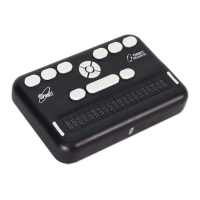Orbit Reader 20 Plus – User guide Version 1.0
Orbit Research Confidential and Proprietary Information 14
with teeth into the device. The SD card should go in smoothly until it gets about a
quarter of an inch from being fully in the device. At this point, you feel a slight
resistance. The card slot works like a toaster, gently push the SD card in until
you hear a click. The card is aligned with the rear edge when properly inserted.
To remove the card, press it in a little until it pops out and then gently remove it.
10.4 About Menus and File Names
The Orbit Reader 20 Plus shows internal menus and file names according to the
language selected from the menu.
10.5 Entering and Exiting Menus
10.6 Device Operational Modes
The Orbit Reader 20 Plus has two functional modes. Stand-Alone mode and
Remote mode.
Stand-Alone mode is the default operational mode and allows you to read, edit,
and browse files without being connected to another device. An SD card must be
inserted in the Orbit Reader 20 Plus while operating in Stand-Alone mode. See
the Stand-Alone Mode section of this document for more information.
Remote mode allows you to connect the Orbit Reader 20 Plus to iPhone
®
, iPad
®
,
and Android™ mobile devices, as well as desktop computers. In Remote mode,
Orbit Reader 20 Plus acts as an input and output device for the remotely
connected host via USB or Bluetooth. See the Remote Mode section of this
document for more information.
To move back and forth between Stand-Alone and Remote modes, use the
following commands:
• To switch to Remote mode: press Select + Right Arrow
• To switch to Stand-Alone mode: press Select + Left Arrow
The Stand-Alone mode provides the following features:
• Menu
• File Manager

